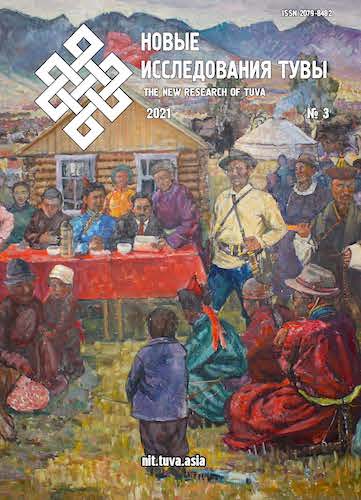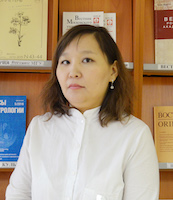A Tuvan manuscript of the Sutra of Eight Luminous as a Booklore Talisman
DOI:
https://doi.org/10.25178/nit.2021.3.13Keywords:
The Sutra of the Eight Luminous; tarni talisman of the Eight Luminous; booklore talisman; buu talisman; Buddhism in Tibet and Mongolia; National Museum of the Republic of Tuva; TuvaAbstract
The article introduces the text of the Mongolian manuscript "Naiman gegen neretü ǰuu tarni" (Talisman-tarni Called Eight Luminous) kept in the National Museum of the Republic of Tuva (M-828). It contains valuable data on the tradition of buu / bu talismans in Buddhism of Tibet and Mongolia.
This manuscript, another version of which is found in the collection of Harbukhyn Balgas (Bulgan aimag of Mongolia), includes images of various talismans, followed by sacred spells and brief description of their functions. In total, thirty-three images of talismans were identified in the manuscript. All pursue various goals — from family welfare and prosperity to the highest goal of the Buddhist path.
The source manuscript is of a compilative character: the list of the talismans, which, obviously, is ritually intended, is followed by a short narrative telling how this booklore talisman named “The Eight Luminous” was given by Buddha Sakyamuni. Description of some tarni talismans (buu tarni) is given according to the text. The article provides also transliteration of the manuscript.
References
Zhitetsky, I. A. (1893) Ocherki byta Astrahanskih kalmykov. Etnograficheskie nablyudeniya 1884–1886 gg. [Astrakhan Kalmyks: Sketches of Everyday Life. Ethnographic Observations, 1884–1886]. Moscow, M. G. Volchaninov. 70 p. (In Russ.).
Mirzaeva, S. V. (2019a) Mongol'skaya rukopis' «Sutry o vos'mi svetonosnyh» (mong. Najman gegeen) iz tuvinskogo arhiva [A Mongolian manuscript of ‘The Sutra on the Eight luminous of heaven and earth’ (mong. Naiman gegen) from the Tuvan archive]. New Research of Tuva, no. 3, pp. 198–207. (In Russ.). DOI: https://www.doi.org/DOI: 10.25178/nit.2019.3.16
Mirzaeva, S. V. (2019b) Mongol'skij perevod «Sutry o vos'mi svetonosnyh» kak obrazec dharani-sutr [A Mongolian Translation of the “Sutra of Eight Luminous” as Dhāraṇī-sūtra]. New Philological Bulletin, no. 4 (51), pp. 409–425. (In Russ.). DOI: https://www.doi.org/10.24411.2072-9316-2019-00117
Mirzaeva, S. V. (2020a) Mongol'skij kommentarij k «Sutre o vos'mi svetonosnyh»: ob osobennostyah zhanra [A Mongolian Commentary on the “Sutra of Eight Luminous”: Features of the Genre]. The New Philological Bulletin, no. 2 (53), pp. 280–296. (In Russ.). DOI: https://www.doi.org/10.24411/2072-9316-2020-00049
Mirzaeva, S. V. (2020b) O dvuh mongol'skih perevodah «Sutry o vos'mi svetonosnyh neba i zemli» [Two Mongolian Translations of the “Sūtra of Eight Luminous of Heaven and Earth” Revisited]. The New Philological Bulletin, no. 4 (55), pp. 371–387. (In Russ.). DOI: https://www.doi.org/10.24411/2072-9316-2020-00117
Mirzaeva, S. V. and Tuvshintugs B. (2019) Mongoloyazychnye versii «Sutry o vos'mi svetonosnyh» (mong. Najman gegeen, kalm. Nәәmn gegәn): ob istorii izucheniya i spiskakh v fondohranilishchakh Rossii [Mongolian-Language Versions of The Sutra of the Eight Luminous (Mong. Найман гэгээн, Kalm. Нәәмн гегән): a History of studies and copies in Russian repositories]. Oriental Studies, no. 12(4), pp. 716–727. (In Russ.). DOI: https://www.doi.org/10.22162/2619-0990-2019-44-4-716-727
Mirzaeva, S. V. and Tuvshintugs B. (2020) Model' buddiiskoi kosmologii v «Sutre o vos'mi svetonosnykh neba i zemli» [The Sūtra of Eight Luminous of Heaven and Earth: a Buddhist cosmological model revisited]. Mongolian Studies, no. 12 (2), pp. 271–287. (In Russ.). DOI: https://www.doi.org/10.22162/2500-1523-2020-2-271-287
Pozdneev, A. M. (1993). Ocherki byta buddiiskikh monastyrei i buddiiskogo duhovenstva v Mongolii v svyazi s otnosheniem sego poslednego k narodu [Sketches of the life of Buddhist monasteries and clergy in Mongolia, in connection with the latter’s relation to the people]. Reprint ed. Elista, Kalm. Book Publ. 512 p. (In Russ.).
Srba, O. (2017) «Ogtorguj gazryn najman gegeen» sudryn asuudald: «Harsh zasah najman gegeen» sudryn nehgehn shineh huvilbar [On the Problem of the Sutra «Eight Lights of Heaven and Earth»: A new variant of Sutra of «Eight Lights Averting Unfavourable»]. In: The Mongolian Kanjur. International Studies / ed.-in-chief S. Chuluun. Ulaanbaatar, Institute of History and Archaeology. 354 p. Pp. 224–246. (In Mong.).
Sharaeva, T. I. (2009) Oberegi v detskom tsikle u kalmykov [Amulets in the child’s rituals among Kalmyks]. Izvestiya Altaiskogo gosudarstvennogo universiteta, no. 4/3 (64/3), pp. 259–262. (In Russ.).
Bawden, Ch. (1962) The Supernatural Element in Sickness and Death According to Mongol Tradition. Part II. Asia Major, vol. 9, pp. 153–178.
Benebell, W. (2016) Tao of Craft: Fu Talismans and Casting Sigils in the Eastern Esoteric Tradition. Berkley, North Atlantic Books. 616 p.
Chiodo, E. (2009) The Mongolian Manuscripts on Birch Bark from Xarbuxyn Balgas in the Collection of the Mongolian Academy of Sciences. Part 2. Wiesbaden, Harrassowitz Verlag. 338 p.
Heissig, W. (1976) Die Mongolischen Handschriften-Reste aus Olon-süme Innere Mongolei (16.–17. Jahrhundert). Wiesbaden, Harrassowitz Verlag. 633 s.
Sazykin, A. G. (1994) Catalogue of the Mongol manuscripts and xylographs preserved in the Library of the Tuvan Ethnological Museum “Sixty Heroes” (Kyzyl). Acta Orientalia Academiae Scientarum Hung, vol. XLVII (3), pp. 327–407.
Tsendina, A. D. (2020) ‘Booklore’ Talismans in Daily Life of the Mongols: A Case Study of Two Collections of Mongolian Manuscripts. Oriental Studies, vol. 13(6), pp. 1632–1640. DOI: https://www.doi.org/10.22162/2619-0990-2020-52-6-1632-1640
Published
How to Cite
For citation:
Mirzaeva S. V. Tuvinskaia rukopis’ «Sutry o vos’mi svetonosnykh» kak knizhnyi talisman [A Tuvan manuscript of the Sutra of Eight Luminous as a Booklore Talisman]. New Research of Tuva, 2021, no. 3, pp. 164-177. (In Russ.). DOI: https://www.doi.org/10.25178/nit.2021.3.13
Issue
Section

This work is licensed under a Creative Commons Attribution-NonCommercial 4.0 International License.

Author(s) license holder(s) grant rights for their work to the journal (grantee of a license) under the simple non-exclusive open license in accordance with Art. 1286.1 «Open license for a research work, work of literature or fine arts», Civil Code of the Russian Federation.
New Research of Tuva publishes articles under the Creative Commons Attribution-NonCommercial license (CC BY-NC).
Since it is an open license, author(s) reserve the right to upload the article to their institutional repository, submit it to another journal (if it allows republications), or republish it on their own website (in full, or in part).
However, several conditions apply here:
a) The republished version must always contain the name(s) and affiliation(s) of the author(s), the original title and the hyperlink to the original version on the New Research of Tuva website;
b) It must be in open access, free of charge, and no category of readers must be in any way whatsoever advantaged over general readership.
c) should the contribution be submitted elsewhere by its author(s) without substantial modification (30% or more of original text unchanged), the body of the article should contain a disclaimer that the original version was published in New Research of Tuva (with a link to the respective page)
The CC-BY-NC is a non-revocable license which applies worldwide and lasts for the duration of the work’s copyright.









